KB Home Bundle
How Does KB Home Thrive in the Competitive Housing Market?
KB Home, a leading name in the U.S. homebuilding industry since 1957, has delivered nearly 650,000 homes, showcasing its enduring presence. In 2024, the KB Home SWOT Analysis revealed strong financial results, with revenues hitting $6.93 billion. This success stems from a unique customer-centric approach and a commitment to sustainable building practices, making it a compelling case study for investors and homebuyers alike.
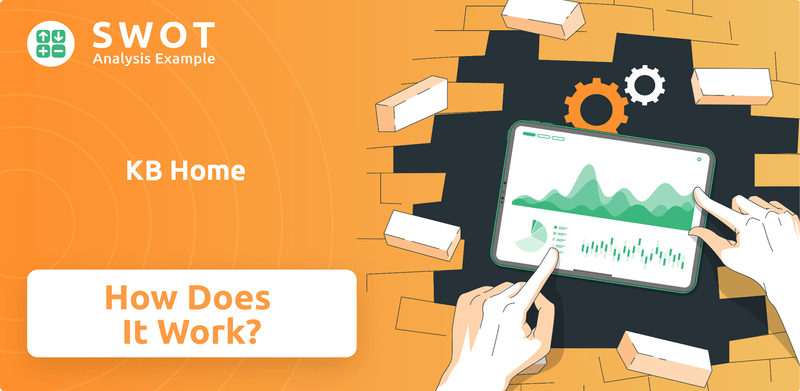
This exploration into KB Home's operations will uncover the secrets behind its "Built to Order" model, which allows for personalized new homes, and its leadership in energy-efficient construction. Whether you're researching KB Home reviews, considering KB Home house plans, or analyzing the real estate market, understanding KB Homes's strategies provides valuable insights. Learn how KB Home navigates the complexities of the homebuilding sector, from its construction process to its financing options, and discover what sets it apart from other builders.
What Are the Key Operations Driving KB Home’s Success?
The core operations of the KB Home Company revolve around the construction and sale of new homes, including single-family homes, townhomes, and condominiums. Their approach centers on providing a personalized homebuying experience. This customer-focused strategy sets them apart from many competitors, aiming to create a unique and interactive process for each buyer.
A key element of their value proposition is the 'Built to Order' model, allowing customers to customize their homes. This includes selecting homesites, floor plans, features, and options. This approach enables buyers to tailor their homes to their specific needs and budget, enhancing the overall value provided. In 2024, the company invested over $2.8 billion in land acquisition and development, with plans for increased investment in 2025.
The operational processes that enable these offerings include strategic land acquisition and development, construction, sales, and customer service. The company operates across several states, with a significant presence in regions like the West Coast, Southwest, Central, and Southeast. This wide geographic reach allows KB Homes to serve a diverse customer base.
This involves identifying, acquiring, and preparing land for home construction. It's a critical step that directly impacts the availability of new homes and the company's growth potential. The company's investment in land acquisition demonstrates their commitment to expanding their operations and community count.
KB Home emphasizes quality construction, using durable materials and skilled craftsmen. The construction process is designed to ensure homes meet high standards. This focus on quality is a key factor in customer satisfaction and the company's reputation.
The sales process involves guiding customers through the homebuying experience, from initial inquiries to closing. KB Home aims to provide excellent customer service, which is reflected in their high customer satisfaction ratings. Strong customer relationships are essential for repeat business and positive word-of-mouth referrals.
KB Home is a leader in sustainable homebuilding, with every home designed to be ENERGY STAR certified. In 2024, a KB Home was estimated to be 55% more energy-efficient than a typical home built in 2006. This focus on energy efficiency benefits the environment and saves homeowners money on utility bills.
The company's value proposition is built on personalization, quality, and sustainability. They offer a unique homebuying experience through their 'Built to Order' model, allowing customers to customize their homes. Their commitment to energy efficiency and sustainable building practices adds significant value for homeowners.
- Personalization: Customers can choose from various options to create a home tailored to their needs.
- Energy Efficiency: Homes are designed to be ENERGY STAR certified, saving homeowners money on utility bills.
- Customer Satisfaction: KB Home is recognized for high customer satisfaction.
- Financial Services: They offer mortgage services through a joint venture and home insurance products.
KB Home also provides mortgage services through a joint venture, offering financing options to homebuyers. Their supply chain and distribution networks support their construction activities across various markets. To learn more about who is buying these homes, you can read about the Target Market of KB Home.
KB Home SWOT Analysis
- Complete SWOT Breakdown
- Fully Customizable
- Editable in Excel & Word
- Professional Formatting
- Investor-Ready Format
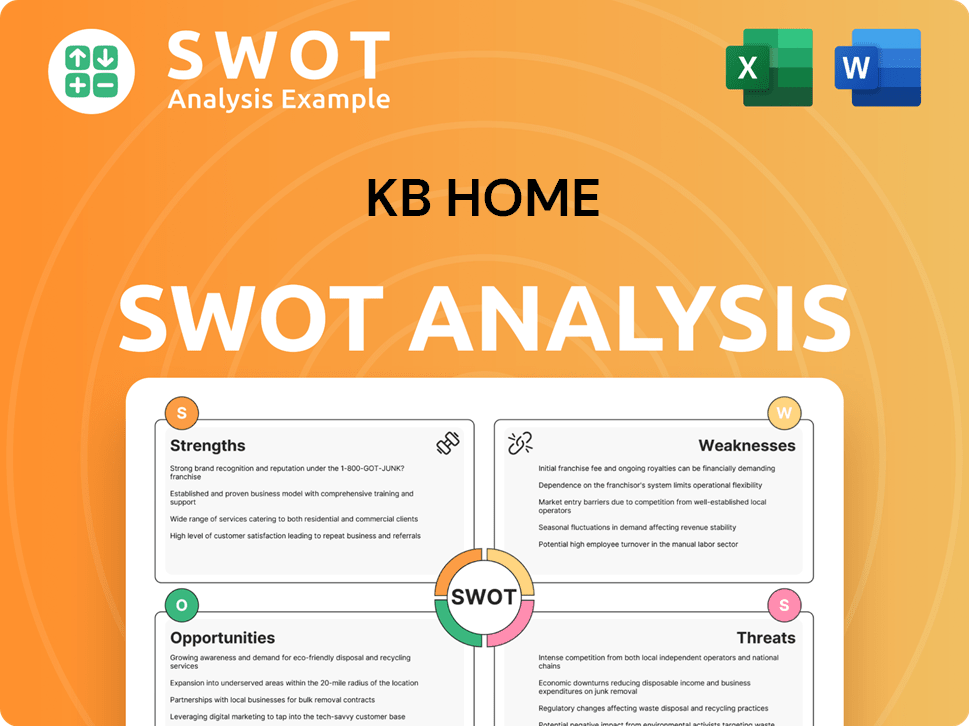
How Does KB Home Make Money?
The primary revenue stream for the KB Home Company comes from the sale of newly constructed homes. In addition to direct home sales, the company also generates revenue through financial services, particularly mortgage banking.
The company's monetization strategies are closely tied to its 'Built to Order' model and emphasis on energy efficiency. This approach allows for flexible pricing and attracts buyers looking for energy-efficient homes.
For the full fiscal year 2024, the company reported total revenues of $6.93 billion. The average selling price of homes delivered in 2024 was approximately $486,900.
The company's revenue streams are primarily divided between home sales and financial services. Home sales make up the vast majority of the total revenue. The financial services segment, which includes mortgage banking, provides a secondary revenue source.
- In the fourth quarter of 2024, housing revenues increased by 19% to $2.00 billion.
- Financial services contributed $13.1 million in pretax income in the fourth quarter of 2024, an 8% increase.
- Over 60% of deliveries in the fourth quarter of 2024 came from built-to-order sales.
- A KB Home built in 2024 could save homeowners an estimated average of $1,800 annually in utility savings compared to a typical resale home.
The company uses several strategies to monetize its operations, including a flexible pricing model and a focus on energy efficiency. The 'Built to Order' model allows for customization and tailored pricing, potentially expanding the customer base. The emphasis on energy-efficient homes attracts eco-conscious buyers and highlights long-term cost savings.
- The 'Built to Order' model enables personalized homes at various price points.
- ENERGY STAR certified homes offer long-term utility cost savings.
- Base price reductions were implemented in mid-February 2025 to stimulate customer traffic.
The company's financial performance in 2024 and outlook for 2025 reflect market conditions and strategic adjustments. The company initially projected housing revenues in the range of $7.00 billion to $7.50 billion for fiscal year 2025. However, due to softer market conditions, the company revised its fiscal year 2025 housing revenue guidance.
- For the fourth quarter of 2024, the average selling price rose 3% to $501,000.
- The initial projection for fiscal year 2025 was housing revenues between $7.00 billion and $7.50 billion.
- The revised fiscal year 2025 housing revenue guidance is $6.6 billion to $7.0 billion.
- The average selling price for 2025 is projected to be between $480,000 and $495,000.
KB Home PESTLE Analysis
- Covers All 6 PESTLE Categories
- No Research Needed – Save Hours of Work
- Built by Experts, Trusted by Consultants
- Instant Download, Ready to Use
- 100% Editable, Fully Customizable
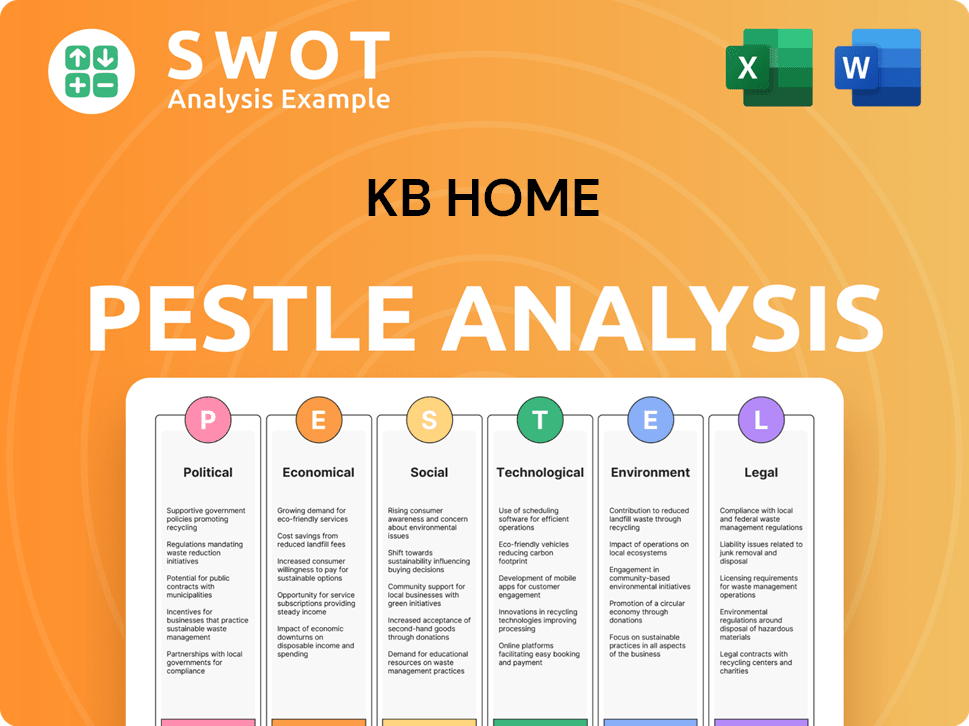
Which Strategic Decisions Have Shaped KB Home’s Business Model?
The journey of the KB Home, a prominent player in the homebuilding industry, is marked by significant milestones, strategic decisions, and a commitment to innovation. From its inception in 1957, the company has consistently adapted to market demands and consumer preferences, establishing itself as a leader in the construction of new homes. This evolution reflects its dedication to providing quality, energy-efficient homes while navigating the complexities of the real estate market.
Strategic moves have been crucial to KB Home's growth and resilience. These include pioneering energy-efficient building practices and expanding into new markets. The company's focus on customer satisfaction and sustainable building practices has further strengthened its position. The company's ability to adapt to economic fluctuations and consumer trends has been key to its sustained success.
KB Home's competitive edge is built on a foundation of innovation, customer focus, and financial stability. The company's 'Built to Order' model allows for personalization, setting it apart from competitors. By integrating sustainable practices and focusing on customer satisfaction, KB Home has created a strong brand reputation, which is a key driver of its success in the competitive homebuilding market.
KB Home built its first ENERGY STAR certified home in 2000 and committed to ENERGY STAR certification for all homes by 2008. In 2010, it became the first national homebuilder to offer WaterSense labeled homes. By 2024, it built its 200,000th ENERGY STAR certified home. In March 2025, KB Home introduced the first wildfire-prepared neighborhood designated by the IBHS.
In response to market challenges, KB Home reduced base prices in mid-February 2025 to stimulate sales. It expanded its market presence by returning to the Atlanta market in January 2025 after a 15-year hiatus. The company focuses on reducing build times and achieving cost reductions through value engineering to maintain profitability.
KB Home's 'Built to Order' model offers exceptional personalization, setting it apart. Strong brand recognition, a reputation for quality, and customer satisfaction also provide a competitive edge. Its leadership in sustainable and energy-efficient homebuilding reduces the total cost of homeownership. The company actively adapts to new trends by investing in technology to enhance the homebuying experience.
In 2024, KB Home achieved an average HERS Index score of 45, ahead of schedule. In 2022, it adopted the EPA's highest water-efficiency standards in drought-prone regions. The company has been recognized as the #1 customer-ranked national homebuilder based on third-party buyer surveys. KB Home's financial stability and strong balance sheet allow for investment and expansion.
KB Home faces challenges like fluctuating interest rates, affordability concerns, and economic uncertainties. The slowdown in net orders in Q1 2025 prompted strategic responses. The company focuses on cost reduction and efficiency to maintain profitability and market share.
- Interest rate fluctuations impact sales and affordability.
- Economic uncertainties create volatility in demand.
- Competition from other builders in the new homes market.
- Rising material costs can affect profitability.
KB Home Business Model Canvas
- Complete 9-Block Business Model Canvas
- Effortlessly Communicate Your Business Strategy
- Investor-Ready BMC Format
- 100% Editable and Customizable
- Clear and Structured Layout
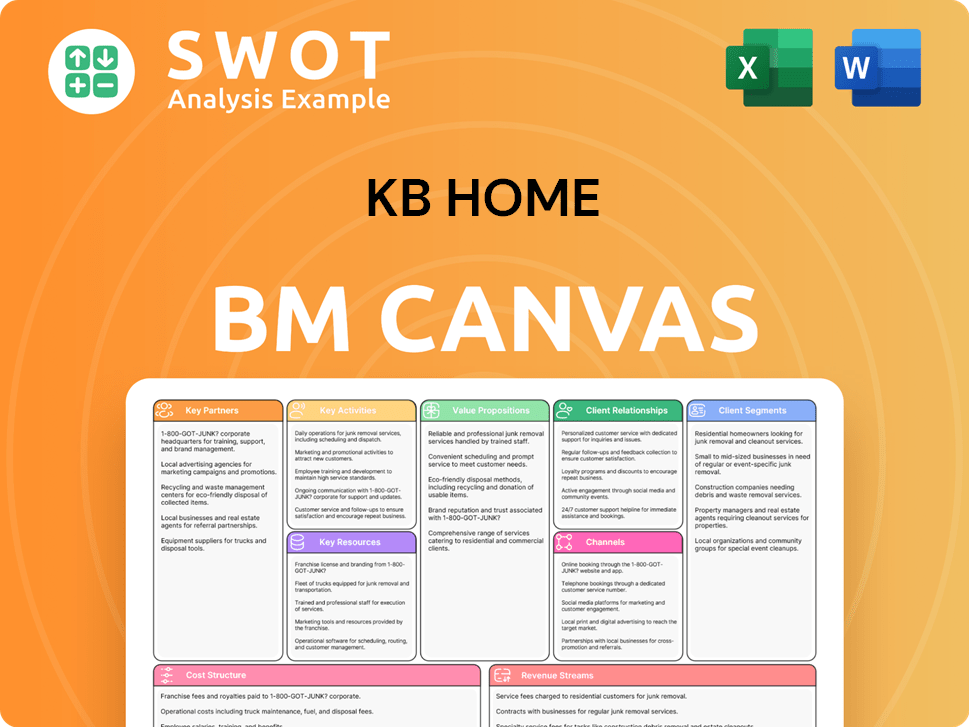
How Is KB Home Positioning Itself for Continued Success?
KB Home, a prominent player in the homebuilding industry, holds a significant market position, operating across 47 markets in the United States. The company consistently aims to secure a top-five position in each of its operational markets. Customer satisfaction is a key focus, reflected in its recognition as a top-ranked national homebuilder in third-party surveys.
The homebuilding sector, including KB Home, faces several risks. These include economic conditions, employment rates, and fluctuations in financial markets. Changes in mortgage interest rates, consumer confidence, and the availability of resale inventory also pose challenges. Furthermore, supply chain disruptions, rising material costs, and labor shortages continue to impact operations. Regulatory changes and emerging competitors add to the complexities. For a deeper understanding, explore the Growth Strategy of KB Home.
KB Home is among the largest homebuilders in the U.S., with a strong presence in numerous markets. Its strategic goal is to be a top-five builder in each market it serves. The company's focus on customer satisfaction has earned it high rankings in customer surveys.
Economic downturns and financial market volatility pose risks to KB Home. Changes in mortgage rates and consumer confidence can affect demand. Supply chain issues and rising costs also present challenges. Competition and regulatory changes add further complexities.
For fiscal year 2025, KB Home anticipates housing revenues between $6.60 billion and $7.00 billion. The company plans to increase land investments to support future growth. Strategic initiatives include expanding scale and profitability.
KB Home projects an average selling price between $480,000 and $495,000 for 2025. The homebuilding operating income margin is expected to be approximately 9.4% for the full year 2025. The company also has a share repurchase authorization.
KB Home is focused on expanding its scale and profitability through strategic initiatives. The company emphasizes its 'Built to Order' model to meet specific buyer demands. Technology investments, such as AI-powered chatbots, enhance customer experience and streamline operations.
- Emphasis on 'Built to Order' model to meet buyer demand.
- Investment in technology, including AI-powered chatbots.
- Commitment to a balanced capital allocation approach, including share repurchases and dividends.
- Continued investment in land acquisition and development to support community count growth.
KB Home Porter's Five Forces Analysis
- Covers All 5 Competitive Forces in Detail
- Structured for Consultants, Students, and Founders
- 100% Editable in Microsoft Word & Excel
- Instant Digital Download – Use Immediately
- Compatible with Mac & PC – Fully Unlocked
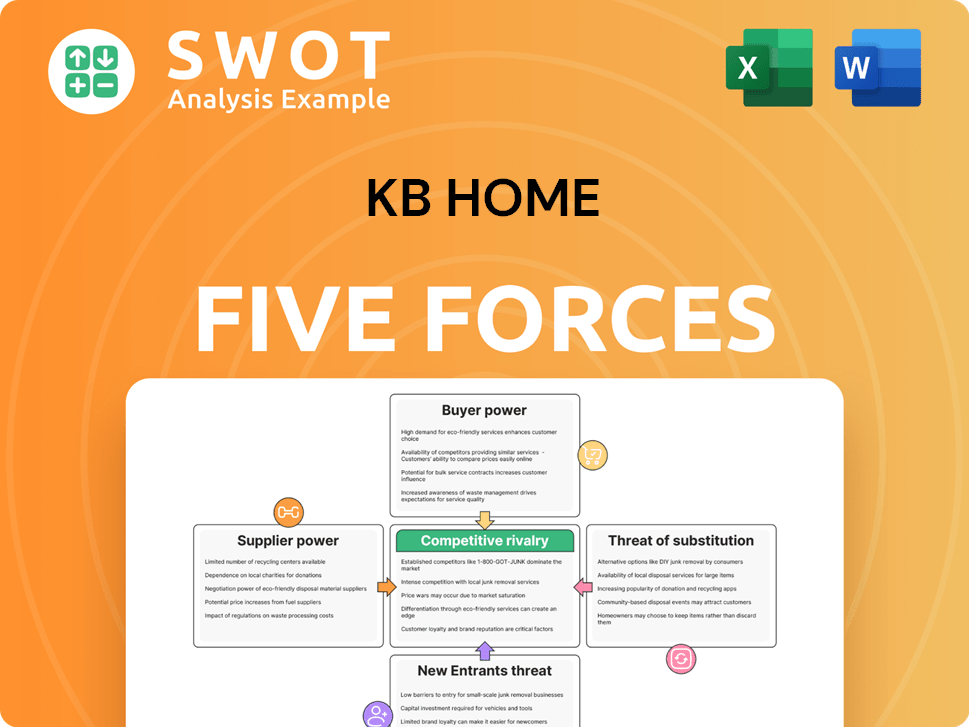
Related Blogs
- What are Mission Vision & Core Values of KB Home Company?
- What is Competitive Landscape of KB Home Company?
- What is Growth Strategy and Future Prospects of KB Home Company?
- What is Sales and Marketing Strategy of KB Home Company?
- What is Brief History of KB Home Company?
- Who Owns KB Home Company?
- What is Customer Demographics and Target Market of KB Home Company?
Disclaimer
All information, articles, and product details provided on this website are for general informational and educational purposes only. We do not claim any ownership over, nor do we intend to infringe upon, any trademarks, copyrights, logos, brand names, or other intellectual property mentioned or depicted on this site. Such intellectual property remains the property of its respective owners, and any references here are made solely for identification or informational purposes, without implying any affiliation, endorsement, or partnership.
We make no representations or warranties, express or implied, regarding the accuracy, completeness, or suitability of any content or products presented. Nothing on this website should be construed as legal, tax, investment, financial, medical, or other professional advice. In addition, no part of this site—including articles or product references—constitutes a solicitation, recommendation, endorsement, advertisement, or offer to buy or sell any securities, franchises, or other financial instruments, particularly in jurisdictions where such activity would be unlawful.
All content is of a general nature and may not address the specific circumstances of any individual or entity. It is not a substitute for professional advice or services. Any actions you take based on the information provided here are strictly at your own risk. You accept full responsibility for any decisions or outcomes arising from your use of this website and agree to release us from any liability in connection with your use of, or reliance upon, the content or products found herein.